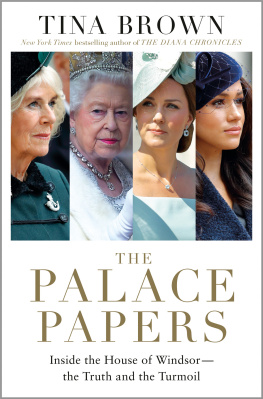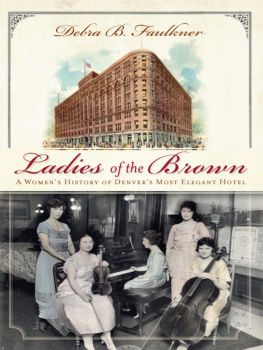A History of Womens Lives in Eastbourne
A History of Womens Lives in Eastbourne
Tina Brown
First published in Great Britain in 2019 by
Pen & Sword History
An imprint of
Pen & Sword Books Ltd
Yorkshire Philadelphia
Copyright Tina Brown, 2019
ISBN 9781526716194
eISBN 9781526716217
Mobi ISBN 9781526716200
The right of Tina Brown to be identified as Author of this work
has been asserted by him in accordance with the Copyright,
Designs and Patents Act 1988.
A CIP catalogue record for this book is
available from the British Library.
All rights reserved. No part of this book may be reproduced or transmitted in
any form or by any means, electronic or mechanical including photocopying,
recording or by any information storage and retrieval system, without
permission from the Publisher in writing.
Pen & Sword Books Limited incorporates the imprints of Atlas, Archaeology,
Aviation, Discovery, Family History, Fiction, History, Maritime, Military,
Military Classics, Politics, Select, Transport, True Crime, Air World,
Frontline Publishing, Leo Cooper, Remember When, Seaforth Publishing,
The Praetorian Press, Wharncliffe Local History, Wharncliffe Transport,
Wharncliffe True Crime and White Owl.
For a complete list of Pen & Sword titles please contact
PEN & SWORD BOOKS LIMITED
47 Church Street, Barnsley, South Yorkshire, S70 2AS, England
E-mail:
Website: www.pen-and-sword.co.uk
Or
PEN AND SWORD BOOKS
1950 Lawrence Rd, Havertown, PA 19083, USA
E-mail:
Website: www.penandswordbooks.com
Introduction

So much of the focus of the suffrage and womens rights tends to centre around the larger towns and cities of England, however if you delve a bit deeper into the history, you will find yourself embarking on an incredible journey which will take you through time and change. When I first started researching Eastbourne I was quite disappointed at the distinct lack of historical content I could find and I almost gave up. However, I decided to take a different approach and was totally absorbed by the subject, tracing the lives of influential ladies who either were born, or spent time in or around the coastal town of Eastbourne during the period 1850 to 1950. As you read through the pages of this book you will see just how the lives of many British women changed so much, in so many ways, including Acts of Parliament being passed, which brought forth new changes in laws in education, work and divorce and marriage rights. There was no doubt that this was a significant time which would go on to shape history for future generations in so many ways.
Struggle and suffrage does not just cover the fights for rights and votes for women, although this was one significant chapter. The struggle so many of the women had to face was on a day to day basis in areas of work and home life and just trying to get their voices heard for the first time.
The Votes for Women campaign was one aspect of a gradual and slow-moving improvement in womens rights that had been an ongoing presence throughout the nineteenth century. The movement also campaigned for the right to divorce a husband, to have the right to education and the right to be able to work in the professions. Many women saw the vote as the catalyst that would give them a say in the laws of the country which affected their daily lives and had the potential for so much change. By the end of the period covered in this book, up and down the country, including in Eastbourne, the voices of women were starting to be heard and acted on.
The struggle and suffrage which many women faced touched every corner of the country, including the resort town of Eastbourne on the south-east coast. The women of this town, famous for being a garden resort by the sea, faced challenging times during both the First and Second World War, with many facing the day to day struggle of making ends meet.
In this book you will meet remarkable and incredible women, who have been linked or connected to the town of Eastbourne. Some were born in Eastbourne others moved there, but they all share the common bond of fighting for the rights and beliefs of women to make their voices heard not just locally, but up and down the country and to improve the lives and opportunities for women for future generations, not just from Eastbourne, but nationally.
Each chapter covers a different aspect of life for women in Eastbourne, from home life and work to educational opportunities and leisure pursuits. There will be a brief focus on any relevant laws which were implemented, with links to how the women of Eastbourne directly fought to change the lives of many women. You will read first-hand accounts from women of the area, and I am very grateful to them for sharing their life experiences with me for this publication. Sharing in the experiences of these women will open your mind to the difficulties they faced on a day to day basis and the dedication and perseverance they showed to their work. My research has brought the women of Eastbourne to life for me in so many ways; so many women, and their fascinating lives, have been introduced to me that I would never have known about. What strikes me as I have been writing this is how you find yourself identifying with them, cheering them on, laughing and crying with them, sharing the life they endured and in turn contributed so much to society.
CHAPTER ONE
Education and Professional Life

During the 100 years from 1850 to 1950, one area which saw significant change was education and professional training, not just for the middle and upper classes, for whom education and learning was available, but also for the working classes and the poor, thus opening educational opportunities to so many more people than before. During the 1860s, Parliament funded most schools and the annual bill for this exceeded 800,000, with growing pressures for more schools to be provided in areas where none had previously existed. Religion played a large part in how and where schools were run and there was huge debate as to whether the state should fund schools which had some religious interest, or whether schools should have no association with any denomination. Things were set to change and in 1869, the National Education League was formed, which began its campaign for free, compulsory and non-religious education for all children, regardless of class. There were also the concerns raised by the industrialists that provision of education was now vital for the country to lead Britain forward in manufacturing; a thought which was backed by much weight in Parliament. If Britain was to remain at the forefront of industry, then it needed to prepare for the future. This meant educating more of the population in subjects which would be of use to industry, business and the country as a whole. When the Education Act was passed in 1870, it was a monumental step as it was the first law which dealt with the provision of education in Britain. It was an important turning point in how education was viewed as it demonstrated the commitment to providing education to all on a national scale. The Act allowed voluntary schools to continue to work as they had done, but it also set up a system of much needed school boards to build and manage the schools in the areas of the country where they were most needed. The school boards were elected locally and were funded by local rates. In these schools, the religious teaching was to be nondenominational, however, specific religious teaching continued in the voluntary schools. Even so, the issue of making education compulsory for all children, boys and girls, had not been settled by this Act and it took the Royal Commission on the Factory Acts in 1876 to recommend that education was to be made compulsory to try and eliminate child labour. In 1880, further changes were made to the Education Act which meant that attending school for education was mandatory for all children between the ages of 5 and 10. However, statistical records show that in the early 1890s attendance for children within this age group was only at 82 per cent; short of what the law had hoped to have achieved.














